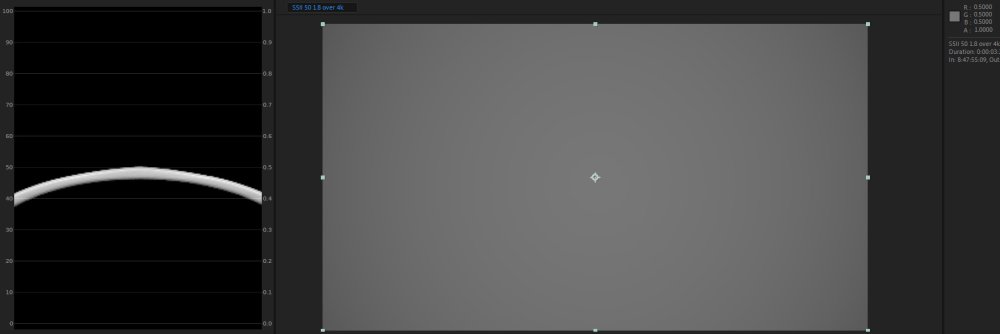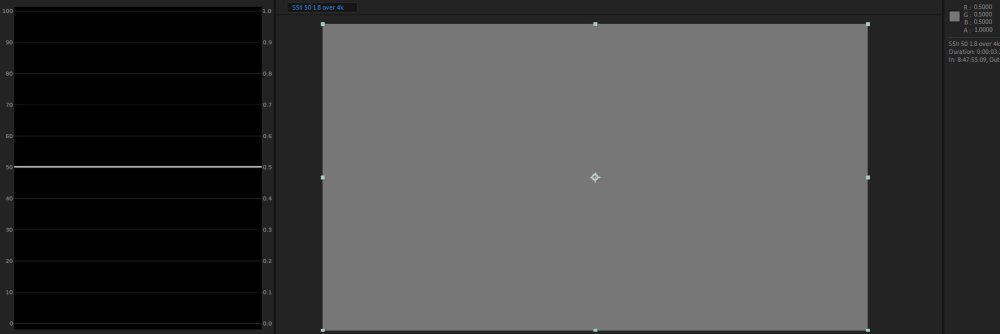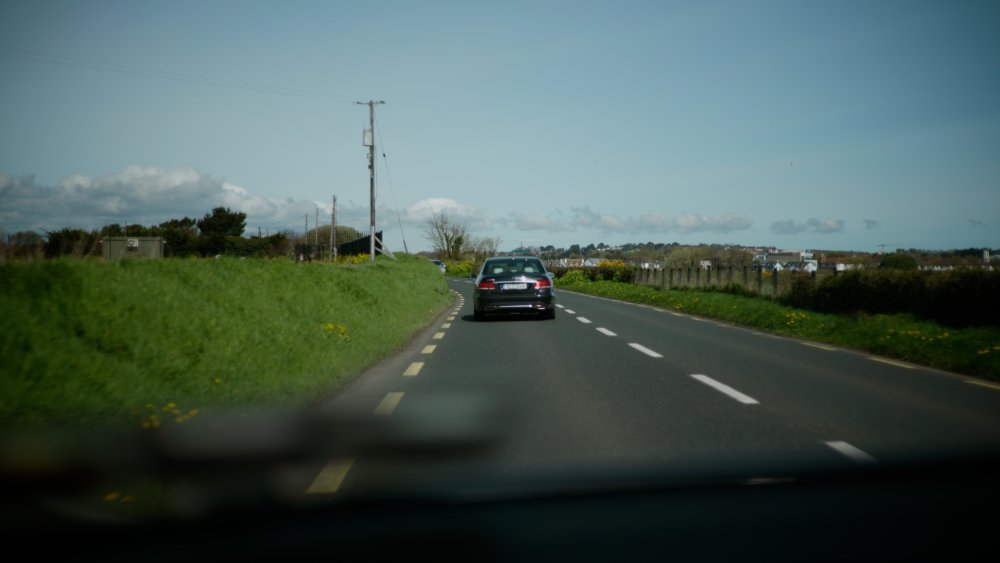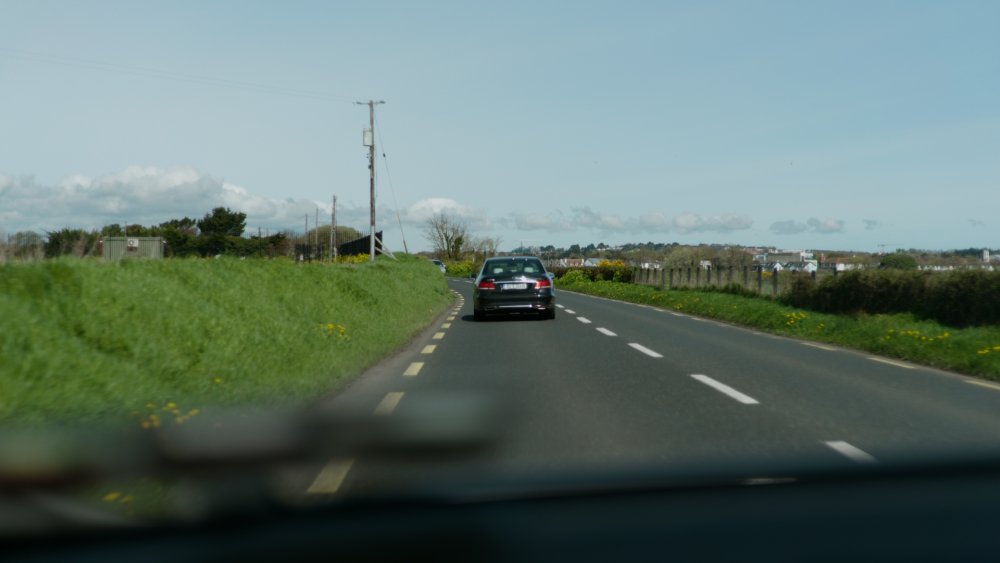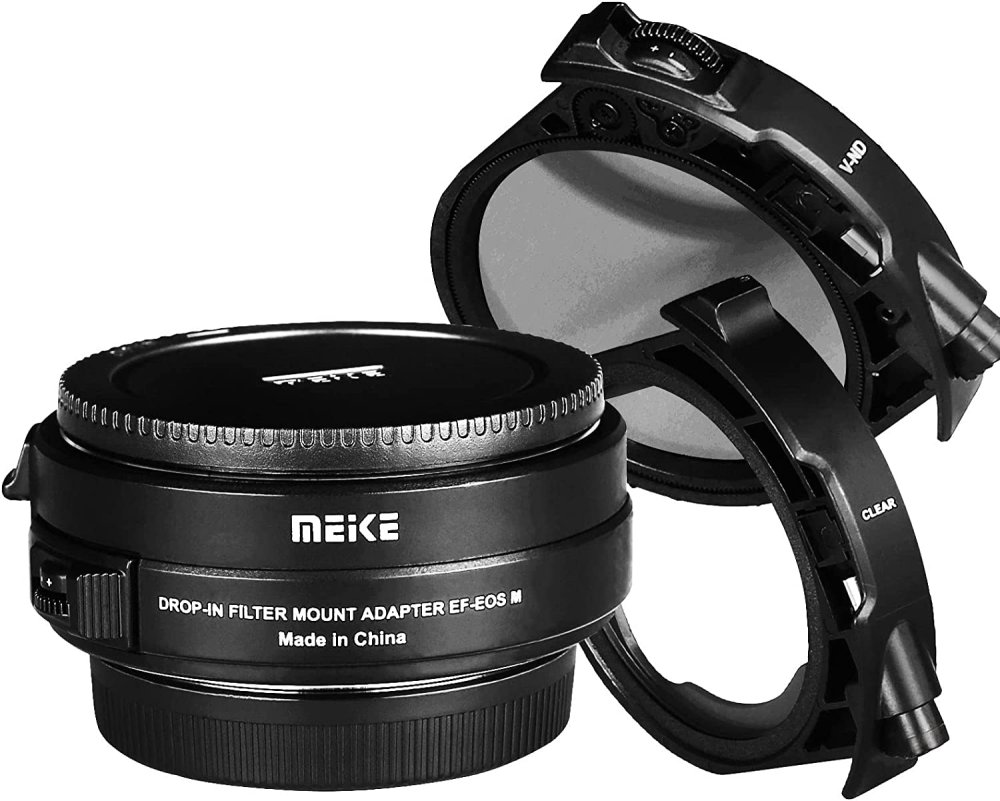Leaderboard
Popular Content
Showing content with the highest reputation on 04/16/2023 in all areas
-

Perfect vignetting correction for any lens you own
OleB and 2 others reacted to hyalinejim for a topic
Because I'm a cheapskate who is recycling his 5D Mk II era EF glass on the latest and greatest Panasonic body thanks to the wonderful Sigma MC21 adapter, I can't take advantage of in-body camera corrections for things like vignetting and lens distortion. And sometimes I would like to do that. It's a lot of fun using the phase detect AF in the S5II to shoot wide open and get in-focus footage with my Canon nifty fifty. But wide open, that lens has something like 2.4 stops of vignetting. That can look really cool sometimes but other times it's not. I first noticed it when editing some interview footage shot against a plain white wall. I wanted to do a little bit of reframing and it looked kind of bad because of the heavy vignetting. I know there are effects that attempt to add or remove vignetting, but I was interested to see if there's a way to do it perfectly, as you can when shooting RAW and using Lightroom. And there is! First of all, I put a semi-opaque piece of white plastic over the lens, focused it to infinity, set the aperture to wide open, pointed it at the sky and did a manual white balance. The aim here, in terms of exposure is to get the brightest part of the image (the exact centre) at exactly 50 IRE. Or you can use ACES to make a linear change to the data to get it looking like this: Then desaturate it, invert it and export as a 16 bit TIFF or similar. Place this image file on a layer above your footage. Change blending mode to Linear Light and Opacity to 50%. Hey, presto! Bye bye, vignetting! (Note: doing this in ACES linear gives perfect results, but it works pretty well in log Rec709 too - the center needs to be 50% IRE in both methods) This is how it looks on real world footage. Before: After: Obviously, this isn't as convenient as doing it in camera as you would need a different vignetting profile for each f stop. But it will allow you to finally shoot your Nocticron f0.95 or whatever wide open without that pesky vignetting! I'm not quite as flush as all that, but I'm quite pleased that my old Canon plastic fantastic that I had in a drawer behaves a little more like Panasonic's version which costs 4 times the price. And a simple Lens Distortion filter at -2 knocks back the distortion. Now if only there was a way of making the focus motor perfectly silent...3 points -

Next-gen Magic Lantern in crowdfunding
Emanuel and one other reacted to QuickHitRecord for a topic
I dusted off my EOS-M today and loaded the new ML. It's feeling a lot more user-friendly than before. 2.8K with accurate monitor display? Heck yes. This is potentially an acceptable level of 'frustrating' and I might actually shoot something with it.2 points -

Next-gen Magic Lantern in crowdfunding
kaylee and one other reacted to QuickHitRecord for a topic
The funding goal was just reached. Thanks to everyone who donated!2 points -

Next-gen Magic Lantern in crowdfunding
Juank reacted to QuickHitRecord for a topic
Forum member @essbe mentioned this in another thread, but I think it deserves it's own topic. Magic Lantern developer theBilalFakhouri is showing compelling evidence that he has figured out how to implement full real-time preview in most raw recording modes across the EOS-M, 100D, 650D, and 700D. Live HDMI output is supported across all recording modes too. Many have found that these are the last two major usability hurdles for these cameras. He is trying to crowdfund £2,214 (about $2750 USD) for the 300 hours he's spent figuring this out before he releases it, and says that he will begin work on full real-time preview on the 5D iii after this campaign gets funded. As of this morning, he's about 2/3 of the way to his goal, but donations have slowed down significantly over the last 24 hours. If you'd like to pitch in, instructions on how to contribute are in the link above. I haven't used either of my ML-enabled cameras in about three years, but this feels like it could be the final chapter in ML history. I would love to see it succeed and keep some of these cameras out of landfill as well as to provide the next generation of broke filmmakers with a truly affordable 16mm/S16 raw camera.1 point -
OK, here is one with a less cinematic aspect ratio: I really do not see why an aspect ratio has to be tied to particular frame rate. I like widescreen aspect ratios and I like realistic motion. I get that low frame rates and widescreen are what some people are used to, but why should that be so limiting? There have not been many cameras that can actually shoot non-crippled 4K 60 fps in widescreen. And I really do not think that soap opera style is defined by a frame rate. TV soap operas were (are?) shot with flat lighting, little contrast (and stilted dialogue deliveries). There is a TV soap-opera look. It is far from the look of my videos. Are football games - shot and shown in 60 fps on TV (Fox, ABC, ESPN) - soap operas? 60 fps = realistic motion. And now we have a portable, inconspicuous, camera with IBIS and great AF that can shoot 4K 60 fps, with oversampling and no additional crop, in widescreen. Which is why I use it. I can shoot the videos I like. And here is a parade in 4K 60p. Lots of motion - why would anyone shoot a a sports event or a parade in 24 fps?1 point
-
Sony lack of firmware updates is getting completely ridiculous!
Davide DB reacted to A_Urquhart for a topic
There is a lot more to a camera than 'image quality' and he did say it was a 'Superior video tool' to which, for video shooters, the FX3 IS superior to the A7SIII. While it's a shame that Sony doesn't bring some of the new features to the A7 line given that we know the hardware can probably take it, I guess that is now Sony's way of saying "the FX line is for the video shooters" and they don't want to blur the lines. I'd be pissed too if I bought the A7SIII as Sony did market it as their video centric hybrid but it seems they now want to charge direction. There is a lot that Sony does that makes no sense to the end user.....1 point -

Next-gen Magic Lantern in crowdfunding
kaylee reacted to Amazeballs for a topic
They need to hack Sony firmware and make a Magic Torchlight or smth. Lots of ppl would support that in a heartbeat. I would.1 point -
Sony lack of firmware updates is getting completely ridiculous!
newfoundmass reacted to Fairkid for a topic
Not whining, just responding to your blanket statement about the A7S III being wrong for people who take their video seriously which is a load of nonsense.1 point -
Ricoh just announced a monochrome version of the Pentax K-3 Mark III DSLR. Evidently, it is 25.73MP, and it shoots up to 4K 30P video. Here is a video showing footage and stills from the camera.1 point
-
Gave the equivilent of a beer. Magic Lantern is wonderful. Love the raw film that these cameras can be hacked to shoot.1 point
-

Fx30
filmmakereu reacted to Django for a topic
FX3 & FX30 just got a major 3.0/2.0 update today that adds Anamorphic De-Squeeze, True 24p, 4K DCI Recording.. and Breathing Compensation: Excellent news for users wanting more cine features and this really starts to tie these cameras to the rest of the FX line. Pretty sure this is the first time an alpha camera gets DCI 4K. About time!1 point -
1 point
-
I am speechless... this is ML cinema camera series 2.0. Yes indeed, this deserves every single donation they can raise. It is the very least decent thing we all users can do. - EAG :- )1 point
-

Fx30
filmmakereu reacted to Emanuel for a topic
Right, 60p gives good cinematic outcome, when slowmo comes to the equation... : D But wait, is it supposed YT to be or look cine-like? As designed for small screen form factor such as mobile phones and alike?!1 point -
Fx30
filmmakereu reacted to ntblowz for a topic
I agree with Django that feels like home video vibe, I really dont like the 50p/60p mode on youtube except for sports which i dont mind. Good thing in PAL land is 25P still feel cinematicish vs 30p on NTSC1 point -

Fx30
filmmakereu reacted to Django for a topic
archaic motion? 24p is still the current cine standard. double frame rate output is literally what is called the soap opera effect: Creating frames in-between the 24 original frames makes the movie (24FPS) look like a soap opera (30/60FPS), and this is something that many viewers don't like. Why does 60fps look like a soap opera? It's due to motion. Soap Operas use cheaper cameras that shoot in 60 FPS rather than film that is 24 FPS. Basically, you've become accustomed to the dreamlike motion of 24 FPS being interpolated for 60 Hz TVs and now attribute higher frame-rates like 48 FPS to that of a lower quality production. haven't we been through this before? not sure why you're getting so offended, you're the one throwing the word "cinematic" around. Sure takes more than a LUT to achieve the look. correct fps is a good place to start but hey keep ignoring this advice and do as you please. just don't get mad if people call out the videoish look of such motion, I'm far from being alone on this. in fact you are probably the only person I know around here or even on YT who consistently outputs 60p on a cine cam.1 point -

Fx30
filmmakereu reacted to Django for a topic
60p output will always have the dreaded soap opera camcorder look. Just convert the file in a 24p timeline if you want it to look "cinematic". Even the ZV-E1 knows this and switches to 23.98p when you enter cinematic mode.1 point -

11 year old 5d MK3 superior to newest releases
PannySVHS reacted to hyalinejim for a topic
Yes, I think the first shot of the sun coming up on the landscape has a fade in of something like sixty seconds. So like, it is indeed getting brighter in the scene but I'm also doing a one minute fade in from black. At the time I probably needed RAW for this. I think it was just before the GH5 10bit 422 era. You mentioned in a DM that the original file downloaded from Vimeo is much cleaner. There is terrible banding in the streaming version for the first minute, but the footage itself is pristine. What's interesting to me looking at it now is the softness of the footage as I'm used to looking at 4K (and I think the softnes looks great). I may have shot it at 2.8K or something, I'm not sure, for 2048 x whatever DCP delivery. But then I may even have blurred it a little bit! I know I definitely blurred the title and end credits as they looked a bit too sharp to me.1 point -

GoPro Hero 11 is approaching Cinema Camera Standards with New Updates
filmmakereu reacted to Emanuel for a topic
Almost twenty years ago or not so far, this level of footage coming from so tiny form factor (body-worn, go figure!) capture devices would put all of us on the edge of the most legit excitement through these or some other boards, this is the pure and straightforward truth... Why not today anymore? Or people now are merely obsessed in-between latitude and the whole subjective mantra on organicity of the outcome? Read it as cinematic structure of the elements to frame, among them the infamous skin tones palette to celebrate this art and craft as the most human synthetic medium. And then? People tend to forget filmmaking is not reality in the same proportion they/we all seek the organic Holy Grail, it's all about something anyhow undeclared fake. That's it. It is what it is. - EAG1 point -

I bought a Pentax K-1
PannySVHS reacted to Andrew Reid for a topic
This first shot is spectacular. Bet it looks even better in full res with the fine noise texture. @QuickHitRecord mentioned a Sony A350 above. This was my first ever non-Canon DSLR back in 2008. I now have two. My advice to everyone is go and seek one out before they're gone forever. It has one of the final Sony CCD sensors ever made, and is pretty high res for the era - about 14 megapixel Image quality is just flat out gorgeous AND it has live view AND phase-detect AF in live view 🙂 It is better than the Leica M8, has even more mojo. And it is $90!1 point -
I bought a Pentax K-1
PannySVHS reacted to MurtlandPhoto for a topic
I knew it at the time, but especially looking back my Nikon D3S is best shooting experience I've ever had. The weight and feeling, the huge and bright viewfinder, the mirror slap, the straight out camera colors, the GRAIN. Everything about that camera was perfect to me. Perhaps it was just the time frame of my career in which I used it, but I benchmark everything about my photos now based upon how that camera would have performed. The punchy colors I like... based on the D3S vivid profile. The grain texture I like... D3S. The emptiness I feel from my Sony's wimpy shutter... spoiled by the glorious D3S mirror slap and shutter. Even the low 12 mp resolution just feels right to me. It still feels awkward nowadays when I edit at 100% in Lightroom and it zooms wayyyyy into my image. That camera was magic to me.1 point -

GoPro Hero 11 is approaching Cinema Camera Standards with New Updates
filmmakereu reacted to Emanuel for a topic
...which proves 4K 120fps works as casual street photography tool. It would be interesting to see more contrasty outcome, B&W as for instance from same frame rate acquisition.1 point -

GoPro Hero 11 is approaching Cinema Camera Standards with New Updates
filmmakereu reacted to Davide DB for a topic
I've just saw this video that shows very well what's going on with these settings. Enable English subtitles and then it's straightforward. NR01=1 effectively improve the image details but you are forced to use a denoiser (he uses Resolve temporal denoiser). LOGB=400 doesn't add any improvement. Just jump to 1'42"1 point -

GoPro Hero 11 is approaching Cinema Camera Standards with New Updates
filmmakereu reacted to Emanuel for a topic
Impressive to say the least : ) You've used anamorphics right? ; ) Do you upsample it once when desqueezed from anamorphic acquistion to the timeline or export?1 point -
GoPro Hero 11 is approaching Cinema Camera Standards with New Updates
filmmakereu reacted to markr041 for a topic
400 ISO. Yes, 4k 120fps has audio recording no matter what the bitrate.1 point -

GoPro Hero 11 is approaching Cinema Camera Standards with New Updates
filmmakereu reacted to Emanuel for a topic
What ISO values? BTW does 4K 120fps offer audio recording included @200 Mbps too?1 point -
GoPro Hero 11 is approaching Cinema Camera Standards with New Updates
filmmakereu reacted to herein2020 for a topic
I really have no bias at all; I literally just grab whatever camera works for me and go shoot with it; I don't do the pixel peeping thing, I am not an IQ purist, I don't sit on YT and watch reviews all day...in fact I am probably one of the least IQ purists on this forum. I also have never even watched a GoPro IQ or review video, I think I watched a single GoPro video on stabilization when I was buying the 8 (the guy mountain biking down a rocky trail and still getting stable footage sold me on the 8), but I have never purchased a GoPro for IQ. BTW I am not basing my opinion on the Hero 8, I am basing it on the videos you posted along with my own firsthand experience with small sensors starting with the Hero 3 and drone cameras. I honestly couldn't care less about sensor size as long as it is producing the IQ that I need. With all of that said, I still see the "sensor/lens haze" in the videos you posted and in every video out of my drones and GoPros. I do think with some very precise color grading and some very specific scenes with perfect lighting and colors in the scene it could be possible to eliminate it, but unless all of those conditions are met, I see the haze instantly when I am watching your sample videos; not because I am looking for it but simply because it is there; in fact I have seen the same haze when using the Canon EF 75-300 F4-5.6 lens, or when looking at dashcam or CCTV footage. The exact same camera with the Canon EF 24-105mm F4 L lens is a night and day difference proving whatever is the weakest link will decide the final IQ. Like I previously mentioned, I think some of it may be due to the lens quality that they use on GoPros or it could just be the resolving power of the sensor; either way it is immediately noticeable to me. But you don't have to convince me, shoot with whatever works for you, maybe when the GoPro 20 comes out they will have eliminated it; either way, its no big deal, my Hero 8 is still perfect for what I got it for and its IQ is good enough for what I need when I need a camera that can do a job none of my other ones can; all I am saying is that for me; GoPro has IQ problems that codecs, bitrates, and color profiles can't fix.1 point -

Is the EOS-M *THE* Digital Super-8 Camera?
filmmakereu reacted to Emanuel for a topic
No idea who's creepier to Doc... Freddy or Homer? : D Love those miniatures, that's true film love, pal : ) Nice zoomshoot BTW (let's not confound with zoom shoot ; )1 point -

Is the EOS-M *THE* Digital Super-8 Camera?
filmmakereu reacted to Matt Kieley for a topic
I decided to play around with ML raw on the EOS M again, and test out my Angeniuex 8-64mm 1.9 Super 8 zoom lens.1 point -

Is the EOS-M *THE* Digital Super-8 Camera?
filmmakereu reacted to BTM_Pix for a topic
I missed this when it was announced a few months ago but Meike have released an EF>M adapter that has a drop in filter slot. It ships as a package with both the Variable ND and clear filters but also has a polariser available too and of course supports all AF and IS functionality €165, I'd say its very reasonably priced for what it will add to EOS-M rigs but of course thats all relative when it costs more than the insanely cheap prices the actual camera itself goes for these days ! I know for many people using EF lenses goes against the grain of using such a small camera but the flip side of that is that with this adapter and a compact EF-S all in one zoom like the Tamron 18-200mm or Sigma 18-250mm (both under €200 used), the EOS-M can become a stabilised, RAW shooting, pick it up and go camcorder for under €500.1 point -

Is the EOS-M *THE* Digital Super-8 Camera?
filmmakereu reacted to tupp for a topic
Compiled ML builds are only around 2MB-3 MB. It appears that one of those files is the git repository (possibly many MB). To install ML on your EOSM, follow the instructions at 03:14 in this video by @ZEEK: A lot of the ML documentation is way out of date. It's best to find recent online tutorials and/or post questions at the ML forums. I don't know where one can find the older builds. Perhaps post the question on the ML forums?1 point

